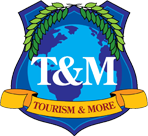Tourism Truth, Advertising, Brochures
August 2013
Tourism is to a great extent a world of marketing. In reality there are three major parts to the tourism product 1) the product itself, 2) the way the product is presented by both the provider (marketing) and perceived by the customer (reputation), and 3) the product delivery or service that is given as part of the product experience. Often tourism professionals become so enthralled with one part of this triangle that they forget one or two of the other sides of the triangle. This triangle holds true in all parts of the travel and tourism industry, be it airline or cruise tourism to restaurants and sports venues. In all cases there must be something to sell, there must be a marketing and reputation component, and there must be some manner to deliver the product to the customer (often called customer service).
Unfortunately, tourism and travel specialists in their desire to put their best foot forward tend to exaggerate their product’s value or at times swerve from the truth. These “marketing truths” as distinguished from “real truths” may make for great print material or ads on television or the web, but in the end cause a great deal of damage to a tourism product including a loss of credibility. One of the biggest mistakes a tourism entity can do is be less than truthful when it comes to marketing its product via brochures.
This month’s Tidbits, by reader request, focuses on brochures and tourism, T&M presents here a number of factors to consider when marketing your product and reasons why truth in advertising and in your brochures is important in establishing a credible tourism industry. Here are also some of the reasons that brochures fail and some of the consequences for brochure mistakes
- Be aware that someone actually may read your brochure besides a visitor. In today’s litigious society, visitors are not afraid to sue. That means that if what you promise is not the same as what exists, your lawyer and you are going to have a very hard time in court. Be careful of generalities such as we provide 100 protection, we are the finest in or other phrases that may have a different ring in a court room than on a brochure rack. If you cannot back it up, then be prepared to be challenged in court!
- Live with peace of mind: When your clients see or hear any form of advertisement, the courts have ruled that these ads must not be misleading, must provide what you say you are providing and if possible be backed up by scientific evidence. Although it is easier to investigate claims that are connected to food and health products than to products that are emotionally appealing, as in the case of much of tourism, visitors soon come to realize that locale is simply not telling the truth. For example, if your hotels are along a highway that is used by large and noisy trucks you can say that they are a good place to rest but you cannot say that your locale is an island of tranquility! In the United States, as in many nations around the world when the government (in the US called: Federal Trade Commission) finds a case of fraud perpetrated on customers, the agency files actions in federal district court for immediate and permanent orders to stop scams; prevent people engaging in fraud from perpetrating scams in the future; freezes their assets; and seeks victim compensation. In today’s world almost anything if not true that you write in a brochure, or publish on the internet or via the media can be held against you.
- Know that brochures are an important secondary form of marketing. Although it is rare for a college-educated middle to upper middle class individual to decide to visit a destination purely on the attractiveness of a brochure, brochures are (or may be) important under any of the following conditions. Once the decision has been made to visit a particular locale then brochures serve three major functions
- they often are the initial “welcome” to an area,
- brochures are a dream motivational tool,
- brochures serve as vehicles for information
- When a vacationer has narrowed down his/her choices to a few destinations, but still is undecided, then brochures may have some influence the decision to visit one location over another.
- During travel, a brochure may catch the voyager’s eye and result in a spontaneous decision to visit a locale along the traveler’s route or close to that route. Especially when one has the flexibility of unscheduled self-drive travel, a brochure may induce a visitor to make a side trip to a specific locale, or make the traveler aware of an attraction at the primary destination of which he/she is unaware.
- Brochures may wet the appetite for return travel. Under the assumption that the traveler has enjoyed his/her trip to an area, brochures may serve as secondary motivators/excuses to return to an area to see/experience sights or events not covered during the first trip. Brochures then need to be good enough to show that the community cares about tourism but not promise or imply so much that the visitor’s expectations are raised to unrealistic levels.
- Make sure that your brochures are:
- Honest
- Concise and precise
- Clear and easy to read
- Colorful
- Use only the active voice rather than passive voice
- Truth in advertising does not necessarily mean lying. It does mean being accurate. Here are some things that you never want to do:
- Do not use a stock or purchased photo. There is perhaps nothing worse than using a photo of a place that does not exist in your locale. Do not advertise lakes, landscapes or countryside from another location.
- Do not provide inaccurate information. If you give hours at attractions then indicate that these hours are subject to change and are accurate only until a specific date. Encourage people to call the attraction for up to the date information.
- Do not promise what you cannot deliver. Do not pretend to be a romantic location if you are not. Instead, say what you are in the most honest of terms, put your best foot forward and make it clear that you can fulfill what you have promised.
- Make sure that your brochures are part of total marketing plan and not apart of separate from the overall plan.
- Make the brochure easy to read. Most people do not read the entire brochure and if the print is too small, then people over forty tend to not read it at all. Too many words provide too much information and too much information ends up becoming the equivalent or no or inaccurate information.



